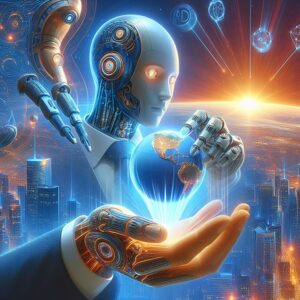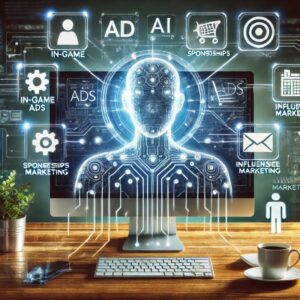Best Beginner’s Roadmap: The Complete AI Agent Development Tutorial
AI agent development tutorial: As an AI agent developer, I’ve witnessed firsthand the revolutionary impact of AI on businesses across various sectors.
In this comprehensive exploration, we’ll delve into the fascinating world of artificial intelligence agents and their potential to transform industries.
The landscape of AI is evolving at a breakneck pace, with new developments emerging almost daily.
One such advancement that caught my attention recently was the release of Devin, an AI software engineer by AI lab Cognition.
This AI agent has demonstrated capabilities that surpass many existing benchmarks in the field of software engineering.
Devin’s prowess extends to training its own AI, adapting to unfamiliar technologies, contributing to production repositories, and even completing freelance projects on platforms like Upwork.
However, it’s crucial to understand that Devin’s impressive performance isn’t solely due to advanced language models.
This AI agent development tutorial will explore these advancements and their implications for the future of AI agent development.
The key lies in its access to additional tools like a terminal, code editor, and browser, effectively making it a well-prompted LLM with an extensive toolkit.
This development has already attracted significant funding, with Cognition securing over $20 million in investments.
While I have reservations about their approach, which I’ll delve into later, this breakthrough underscores the vast potential we’ve only begun to tap in the realm of AI agents.
We strongly recommend that you check out our guide on how to take advantage of AI in today’s passive income economy.
Table of Contents
My Experience with AI Agent Development
Over the past year, I’ve had the privilege of developing custom AI agent systems for a diverse range of clients.
These projects have spanned from small firms with just five employees to large corporations boasting over 30,000 staff members.
This experience has given me unique insights into the practical applications and challenges of AI agent development.
In this AI agent development tutorial, I’ll share my knowledge and guide you through creating your own fully functional AI-powered Social Media Marketing Agency (SMMA).
By the end of this guide, you’ll be equipped to generate ad copy, create stunning visuals with DALL-E 3, and seamlessly post content on Facebook.
The Game Plan
Here’s what we’ll cover in this comprehensive AI agent development tutorial:
- An overview of the emerging AI Agent Developer role
- Understanding the true nature of AI Agents
- Exploring popular AI agent frameworks
- An inside look at my personal framework
- A step-by-step guide to building a functional SMMA
So, grab a cup of coffee, get comfortable, and let’s embark on this exciting journey into the world of AI agent development.
The AI Agent Developer Role: A New Frontier
As we delve deeper into this AI agent development tutorial, it’s crucial to understand the emerging role of AI Agent Developers.
This position is set to become one of the most sought-after skills in 2024 and beyond.
Many experts predict that we’re heading towards full labor automation within the next decade.
While I concur with this projection, I believe it won’t be a self-driven process.
As AI models become increasingly sophisticated, they’ll undoubtedly gain a broader understanding of the world.
However, they’ll never inherently know how specific companies operate internally, simply because such data is rarely made public.
The events of 2023 demonstrated that businesses aren’t content with merely incorporating standard LLMs into their processes.
They desire customization and enrichment with their proprietary data.
This is where the role of AI Agent Developers becomes pivotal.
The Limitations of Generic AI Solutions
Labs like Cognition, despite their impressive advancements, may face challenges due to their lack of customization capabilities.
To fully automate a company like Google, for instance, we need more than just a super-intelligent AI developer.
We must ensure that this AI has access to all necessary tools, infrastructure, and internal knowledge before it can perform any tasks effectively.
This is the niche that AI Agent Developers are poised to fill.
Defining the AI Agent Developer Role
An AI Agent Developer is a professional who fine-tunes AI agents based on internal business processes.
In my role as an AI Agent Developer, my primary responsibility is to equip AI with all the necessary resources and ensure it knows how and when to use them in production environments.
The skills required for this role can vary significantly from project to project, a topic that deserves its own dedicated discussion.
If you’re interested in learning more about the specific skill set needed for AI agent development, let me know in the comments, and I’ll consider creating a separate video on this subject.
Understanding AI Agents: Beyond the Basics
As we progress through this AI agent development tutorial, it’s essential to gain a deeper understanding of what AI agents truly are.
Many people simplify AI agents as just a combination of instructions, knowledge, and actions.
While this description isn’t entirely incorrect, it doesn’t capture the full essence of AI agents.
To truly grasp what AI agents are, we need to explore the distinction between standard 1.0 AI automations and more sophisticated 2.0 AI agent-based applications.
The Limitations of 1.0 AI Automations
Consider a basic customer support automation where an LLM is tasked with labeling incoming emails and responding to them, pulling additional context from a vector database.
Does this scenario feel like a true AI agent or mere automation?
You might have noticed that it doesn’t quite fit the bill of an agent. But why?
The key difference lies in the lack of decision-making capabilities.
In 1.0 AI automations, every procedure, such as context retrieval, response generation, and labeling, is hardcoded into the backend logic.
This rigid structure means the system cannot deviate from its programmed logic, regardless of the situation.
While this approach works well for certain use cases, it fails when unexpected circumstances arise.
The Flexibility of 2.0 AI Agent-Based Applications
In contrast, 2.0 AI Agent-Based applications take a more flexible approach.
While they still equip the agent with necessary tools, context, and instructions, they grant the agent autonomy in how to utilize these resources.
Instead of feeding context into the prompt on every request, you empower the agent to retrieve information only when needed.
This flexibility allows the agent to adapt to various scenarios, recognizing when it’s dealing with inquiries outside its expertise and leveraging other available tools or human resources as necessary.
AI Agents: A Paradigm Shift
In essence, AI agents represent a new way of thinking about AI applications.
It’s a paradigm shift rather than a simple technique.
In my agency, we began with basic 1.0 AI automations, but as clients experienced the benefits, they desired more advanced capabilities and automation of increasingly complex tasks.
Eventually, we reached a point where the term “automation” no longer adequately described our work.
It more closely resembled outsourcing, as some of the processes we automated previously required multiple people to carry out manually.
The Role of Agent Swarms in AI Development
As we continue our AI agent development tutorial, let’s explore the concept of agent swarms and their significance in AI development.
To truly grasp the idea of agent swarms, it’s crucial to understand that all intelligence is environment-dependent.
For instance, while I excel in programming, I’m completely out of my element in a kitchen.
I wouldn’t last a day as a cook, even in a fast-food restaurant.
This principle applies equally to AI agents and human employees.
The Limitations of Single Agents
Even if we reach GPT-100 levels of AI sophistication, I would still advise against assigning numerous different responsibilities to a single agent.
There are two primary reasons for this:
- Efficiency: Removing unnecessary information for a given process saves on tokens, making the system more economical.
- User Experience: Even if an advanced AI like GPT-100 could handle multiple roles without confusion, the users of such a system would likely find it overwhelming and difficult to interact with.
The Benefits of Agent Swarms
Agent swarms allow us to separate responsibilities for different environments, mimicking real-world organizational structures.
This approach offers three main advantages:
- Reduced Hallucinations: I’ve observed that after adding 7 to 10 tools to a single GPT-4 agent, it starts to show signs of confusion. Splitting these tools among multiple agents almost entirely eliminates this issue.
- Complex Task Handling: The longer the sequence of your agents, the more tasks they can handle without direct supervision, enabling the outsourcing of increasingly complex processes.
- Scalability: Most of my clients don’t stop at a single AI Agent and often seek to automate increasingly complex processes over time. With agent swarms, instead of adjusting your existing system and debugging it repeatedly, you can simply add another agent while leaving previous agents untouched.
AI Agents as a Service
The scalability challenge is so common among my clients that we’re launching an AI Agents as a Service subscription.
This service allows business owners to pay a fixed monthly fee for the development of as many AI agents as needed, working on them one at a time.
Our goal is to provide a flexible and scalable solution that grows with your needs.
If you’re interested in this service, you can apply now using the link below at a temporarily discounted price.
Popular AI Agent Frameworks: An Overview
As we delve deeper into this AI agent development tutorial, it’s important to understand the landscape of existing multi-agent frameworks.
Let’s explore some of the most popular options available to developers.
AutoGen by Microsoft
AutoGen, developed by Microsoft, is perhaps the most well-known framework in this space.
Its primary feature is multi-agent chats, which were groundbreaking when first introduced.
However, AutoGen has some limitations:
- It offers extremely limited conversational patterns that are difficult to customize.
- The next speaker in a conversation is determined by an additional model call, which can be inefficient and lead to uncontrollable outcomes.
- Many users report frequent agent hallucinations due to a lack of clear separation of concerns in tool execution.
CrewAI
CrewAI is a more recent framework that has gained significant attention.
It introduces the concept of “process” into agent communication, providing some control over communication flow.
However, CrewAI also has its limitations:
- Like AutoGen, it offers only sequential or hierarchical communication options, which may not reflect real-world organizational structures.
- The manager agent is hardcoded, limiting flexibility in more complex scenarios.
- It’s built on top of LangChain, which predates function-calling models, resulting in limited tool descriptions and lack of automatic type checking or error correction.
While CrewAI does offer some advantages, such as compatibility with open-source models, its limitations make it less suitable for many production environments.
Introducing Agency Swarm: My Custom Framework
In response to the limitations of existing frameworks, I developed Agency Swarm, a custom framework designed for production-ready AI agent development.
Key features of Agency Swarm include:
- No hard-coded prompts, allowing for easy customization
- Uniform communication flows
- Reliable production performance with automatic type checking and validation for all tools using the Instructor library
- A thin wrapper around OpenAI’s Assistants API, providing full control over all agents
Agency Swarm allows for flexible communication structures, whether you prefer sequential, hierarchical, or complex multi-level flows.
Agents determine who to communicate with based on their own descriptions, providing a more natural and adaptable system.
Why Use the Assistants API?
The Assistants API might not seem significantly different from previous OpenAI endpoints at first glance.
However, it offers a crucial advantage for AI agent development: state management.
With the Assistants API, you can attach instructions, knowledge, and actions directly to each new agent.
This allows for clear separation of responsibilities and seamless system scaling without worrying about underlying data management or tool confusion between agents.
Building Your First AI Agent Swarm
Now that we’ve covered the theoretical aspects in this AI agent development tutorial, let’s dive into the practical implementation using Agency Swarm.
To create your agent swarms, you need to understand three essential entities: Agents, Tools, and Agencies.
Agents in Agency Swarm
Agents in Agency Swarm are wrappers around assistants in the Assistants API.
They include methods that simplify the agent creation process, such as:
- Automatic file uploading from specified folders
- Storing agent settings in a settings.json file
- Automatic updating of existing assistants on OpenAI when configurations change
Key parameters for creating an agent include:
- Name
- Description
- Instructions
- Model
- Tools
- Files folder
- Schemas folder
- Tools folder
Creating Tools with Instructor
Tools are a crucial component of any AI agent-based system.
In Agency Swarm, we use Instructor to create tools, which integrates the Pydantic data validation library with function calls.
This ensures that all agent inputs are validated before any actions are executed, minimizing production errors.
To create a tool using Instructor:
- Create a class that extends the BaseTool
- Add your class properties
- Implement the run method
- Use docstrings and field descriptions to help the agent understand when and how to use the tool
You can also add validation logic using field or model validators from Pydantic.
To help you get started faster, I’ve created a custom GPT tool generator, which you can find on our Discord.
Agencies: Bringing It All Together
An Agency in Agency Swarm is a collection of agents that can communicate with each other.
When initializing your agency, you add an Agency chart that establishes communication flows between your agents.
Communication flows in Agency Swarm are uniform and can be defined in any way you want:
- Agents in the top-level list can communicate with the user
- Agents in second-level lists can communicate with each other
- Communication flows are directional, mimicking real-world organizational structures
Building a Social Media Marketing Agency: A Practical Example
To demonstrate the entire process from start to finish in this AI agent development tutorial, let’s create our own social media marketing agency using Agency Swarm.
Setting Up Your Environment
First, install Agency Swarm using the command:
pip install agency-swarmTo get started quickly, run:
agency-swarm genesisThis will activate the Genesis agency, which will create all your agents for you.
Defining Your Agency Structure
For our Facebook marketing agency, we’ll need agents that can:
- Generate ad copy
- Create images with DALL-E 3
- Post ads on Facebook
After running the genesis command, we’ll have an initial agency structure with three agents:
- Ad Copy Agent
- Image Creator Agent
- Facebook Manager Agent
We’ll adjust the communication flows to adopt a sequential structure.
Fine-tuning Your Agents and Tools
Once the agents are created, we’ll need to test and fine-tune all the tools.
Let’s start with the Image Generator tool:
- Update the OpenAI package version
- Adjust the API call to use the DALL-E 3 model
- Implement a ‘save image’ method to store the generated image locally
- Use shared state to pass the image path between agents
Next, we’ll adjust the AdCopyGenerator tool and create additional tools for the Facebook Manager agent:
- Ad Campaign Starter
- Ad Set Creator
- Ad Creator
Setting Up Facebook Integration
To integrate with Facebook:
- Install the Facebook Business SDK
- Create a Facebook app
- Add the Marketing API product
- Set up your App ID, App Secret, and Access Token in your environment file
Refining Instructions and Communication Flows
The final step is to refine the instructions for each agent and adjust the communication flows:
- Include specific instructions on how agents should communicate with each other
- Specify a step-by-step process for agents to follow
- Adjust the communication flows to allow direct communication with the Facebook Manager agent
Running Your Agency
To run your agency, simply execute:
python agency.pyThis will open a Gradio interface where you can interact with your AI-powered social media marketing agency.
Conclusion and Future Developments
As we wrap up this AI agent development tutorial, it’s clear that the field of AI agents is rapidly evolving and full of potential.
We’ve covered the basics of AI agent development, explored various frameworks, and built a functional social media marketing agency using Agency Swarm.
Looking ahead, my roadmap for Agency Swarm includes:
- Establishing multi-agency communication for complex use cases
- Enhancing the Genesis agency to test other agencies during creation
- Regular updates to incorporate the latest features from the OpenAI Assistants API, such as memory and web browsing
I hope this AI agent development tutorial has been informative and inspiring.
If you’re interested in joining our team or learning more about AI agent development, connect with us on Discord.
We’re always looking for new talent, especially those with experience using this framework.
Thank you for following along, and don’t forget to like and subscribe for more content on AI agent development!
Frequently Asked Questions
How to build your own AI agent?
Building your own AI agent involves several key steps:
- Define the agent’s purpose and goals.
- Choose an appropriate framework or platform for development.
- Design the agent’s architecture, including its knowledge base and decision-making processes.
- Implement the agent’s core functionalities using programming languages like Python.
- Integrate necessary tools and APIs for specific tasks.
- Train the agent using relevant data and fine-tune its performance.
- Test the agent thoroughly in various scenarios.
- Deploy the agent and monitor its performance in real-world applications.
This AI agent development tutorial provides a comprehensive guide to help you through this process.
How to create an agent from scratch?
Creating an AI agent from scratch requires a more in-depth approach:
- Start by thoroughly researching AI concepts and machine learning algorithms.
- Choose a programming language (Python is popular for AI development).
- Develop a strong understanding of natural language processing (NLP) techniques.
- Design the agent’s architecture, including its input processing, decision-making mechanisms, and output generation.
- Implement the core algorithms for the agent’s cognitive processes.
- Create a knowledge base or integrate with existing databases.
- Develop interfaces for the agent to interact with its environment and users.
- Implement learning mechanisms for the agent to improve over time.
- Rigorously test and debug the agent in various scenarios.
- Continuously refine and optimize the agent’s performance.
This approach requires more time and expertise but offers greater customization and control over the AI agent’s capabilities.
What are the 5 types of AI agents?
In AI agent development, we typically recognize five main types of AI agents:
- Simple Reflex Agents: These agents act based on the current percept, ignoring the percept history. They use condition-action rules to make decisions.
- Model-Based Reflex Agents: These agents maintain an internal state that depends on the percept history. They use this state along with the current percept to choose actions.
- Goal-Based Agents: These agents work towards predefined goals. They consider the desirability of their actions’ outcomes when making decisions.
- Utility-Based Agents: These agents not only work towards goals but also consider the quality of the outcomes. They use a utility function to measure and compare different world states.
- Learning Agents: These agents can improve their performance over time through experience. They have the ability to learn and adapt to new situations.
Understanding these types is crucial in AI agent development, as it helps in choosing the most appropriate architecture for specific applications.
What is AI agent development?
AI agent development is the process of creating intelligent software entities capable of perceiving their environment, making decisions, and taking actions to achieve specific goals. This field combines various aspects of artificial intelligence, including:
- Machine Learning: Enabling agents to learn from data and improve their performance over time.
- Natural Language Processing: Allowing agents to understand and generate human language.
- Computer Vision: Equipping agents with the ability to interpret and analyze visual information.
- Knowledge Representation: Structuring information in a way that agents can use for reasoning and decision-making.
- Planning and Problem-Solving: Developing algorithms for agents to formulate and execute plans to achieve their goals.
- Robotics: Integrating AI agents with physical systems for real-world interactions.
- Ethics and Safety: Ensuring that AI agents behave in alignment with human values and safety considerations.
AI agent development encompasses the entire lifecycle of creating these intelligent systems, from conceptualization and design to implementation, testing, deployment, and ongoing maintenance. As demonstrated in this AI agent development tutorial, the field is rapidly evolving, with new frameworks and methodologies constantly emerging to address increasingly complex challenges and applications.

We strongly recommend that you check out our guide on how to take advantage of AI in today’s passive income economy.




